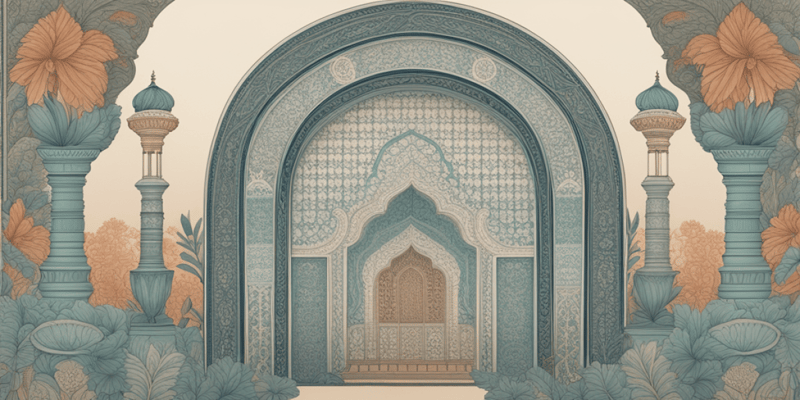12 Questions
What was the main demand of the Muslim League when it was formed in 1906?
Separate electorates for Muslims
Who led successful local movements in Champaran and Ahmedabad upon arriving in India in 1915?
Mahatma Gandhi
What controversial legislative bill strengthened police powers and allowed arrests without trial in India, April 1919?
Rowlatt Act
What incident led to the withdrawal of the Non-Cooperation Movement in 1922?
Chauri Chaura incident
Under which act were elections held for provincial legislatures in 1935?
Government of India Act
Which movement had the slogan 'Do or Die' and led to the arrest of leaders like Gandhiji in 1942?
Quit India Movement
When did Indians begin to resist British rule?
After the failed Revolt of 1857
Which political association was formed first with the goal of empowering Indians in decision-making?
Indian National Congress
Which issue was NOT advocated by the Indian National Congress?
Increase in British control
What event led to the birth of the Swadeshi movement?
Partition of Bengal in 1905
Who were the leaders advocating for peaceful resistance within the Indian National Congress?
Dadabhai Naoroji and Feroz Shah Mehta
What did the Swadeshi movement aim to promote?
Indian languages and National Education
Study Notes
- The text discusses the making of the national movement in India from the 1870s to 1947.
- Indians began to resist British rule after the failed Revolt of 1857, with the realisation that India was for its people and its resources were meant for all.
- Political associations such as the Indian National Congress were formed after 1850, with the goal of empowering Indians to take decisions regarding their affairs.
- Discontent against the British grew stronger during the 1870s and 1880s, with the enactment of laws such as the Arms Act (1878), the Vernacular Press Act (1878), and the Ilbert Bill (1883) causing resentment.
- The Indian National Congress was formed in 1885 with leaders like Dadabhai Naoroji, Feroz Shah Mehta, Badruddin WC Banerjee, and RC Dutt, among others.
- The Congress advocated insults for greater Indian representation in government, separation of the judiciary from the executive, and repeal of the Arms Act and freedom of speech.
- Economic issues were also raised, such as the need for revenue reduction, cut in military expenditure, and more funds for irrigation.
- The Congress split into moderates and extremists in 1907, with moderates wanting peaceful resistance and extremists advocating aggressive methods.
- The partition of Bengal in 1905 led to the birth of the Swadeshi movement, which boycotted British institutions and goods, and encouraged the use of Indian languages and National Education.
- The Muslim League was formed in 1906, demanding separate electorates for Muslims.
- The Lucknow Pact was signed in 1916, with the Congress and the Muslim League deciding to work together for representative government in the country.
- The First World War (1914-1918) led to the growth of mass nationalism, with peasants, tribal people, students, and women joining the struggle against British rule.
- Mahatma Gandhi arrived in India in 1915 and led successful local movements in Champaran and Ahmedabad, and a millworker's strike in 1918.
- The Rowlatt Act of 1919 was a controversial legislative bill, with the British passing it despite widespread protests and opposition.
Note: This summary is for informational purposes only, and is not intended to serve as a replacement for reading the original text.- The ACT (Rowlatt Act) limited fundamental rights and strengthened police powers, allowing arrests without trial in India, April 1919.
- Mahatma Gandhi initiated the non-violent satyagrah against the ACT on April 6, 1919.
- There were various demonstrations against British rule, with Hindus and Muslims united, leading to the Khilafat and Non-Cooperation movements in 1920.
- The Turkish Sultan, the religious head of Muslims, was imposed upon by the British with a harsh treaty, leading to the Khilafat agitation and the start of the Non-Cooperation Movement in 1921.
- The movement gained momentum as thousands joined, with students leaving schools, lawyers giving up practices, legislatures boycotted, and public protests for self-rule.
- The Patidar Peasants in Gujarat organized non-violent campaigns against high land revenue demanded by the British, as well as attacking liquor shops.
- Gandhiji believed in building class unity and was regarded as a savior for millions in India.
- In 1922, a violent incident at Chorichora led to the withdrawal of the Non-Cooperation Movement.
- In 1929, the Congress fought for Purna Swaraj under Jawaharlal Nehru's presidency, leading to the declaration of Independence Day on January 26, 1930.
- The British introduced a law controlling the manufacture and sale of salt in 1930, leading to Gandhiji's iconic Salt March, breaking the law to make salt.
- Elections were held for the provincial legislatures under the Government of India Act of 1935, with Congress's remarkable success.
- The Quit India Movement was protecting against British rule in 1942, with the slogan "Do or Die," leading to the arrest of Gandhiji and other leaders.
- The British accepted the demand for India's independence, but partition became inevitable due to the League's demand for independent Muslim states.
- India became independent on August 15, 1947, but was partitioned into India and Pakistan, combining the joy of independence with the sorrow of partition.
Explore the journey of the Indian national movement from the late 19th century to gaining independence in 1947. Learn about key events, leaders, movements, and milestones that shaped India's struggle against British colonial rule.
Make Your Own Quizzes and Flashcards
Convert your notes into interactive study material.




